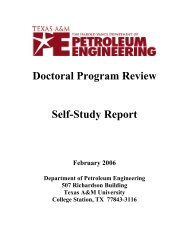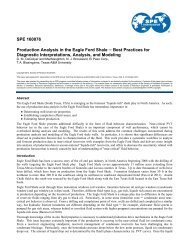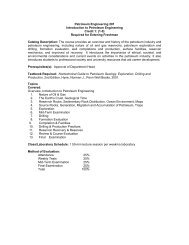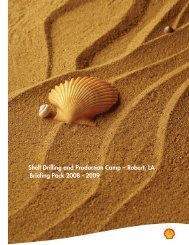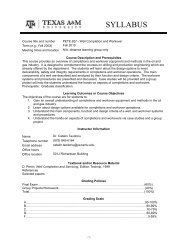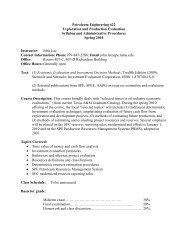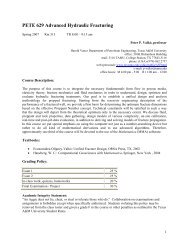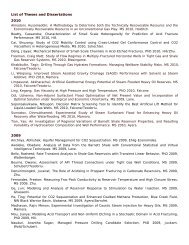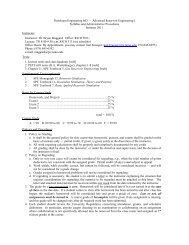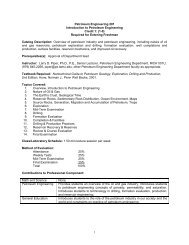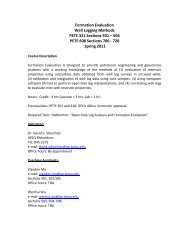Crisman Annual Report 2009 - Harold Vance Department of ...
Crisman Annual Report 2009 - Harold Vance Department of ...
Crisman Annual Report 2009 - Harold Vance Department of ...
Create successful ePaper yourself
Turn your PDF publications into a flip-book with our unique Google optimized e-Paper software.
Aquifer Management for CO 2<br />
Sequestration<br />
Objectives<br />
Among various possible solutions to mitigate the<br />
increasing concentration <strong>of</strong> “greenhouse gases” in<br />
the atmosphere, geological sequestration seems the<br />
most attractive and promising one. This research<br />
explores carbon dioxide sequestration in deep saline<br />
aquifers, and will study issues related to aquifer<br />
pressurization, monitoring, and risk mitigation using<br />
a numerical reservoir simulator that models the<br />
multiphase flow physics <strong>of</strong> CO 2<br />
process using the<br />
Peng-Robinson equation <strong>of</strong> state (EOS).<br />
Approach<br />
Simulations clearly indicated that bulk CO 2<br />
injection<br />
into a single well could rarely inject the volume <strong>of</strong><br />
CO 2<br />
produced by the power plant in a typical aquifer,<br />
and that multiple wells would be required. In an<br />
array <strong>of</strong> injection wells, the aquifer volume allotted<br />
to each injection well is limited by interference with<br />
other injection wells. Therefore, modeling <strong>of</strong> CO 2<br />
injection must consider a closed outer boundary,<br />
and bulk injection in a closed system will pressurize<br />
the aquifer. Simulations confirm this conclusion.<br />
An analytical model developed for this study extends<br />
a previously published one for an open aquifer to<br />
a closed aquifer. A spreadsheet model provides<br />
similar results to detailed simulation in a fraction <strong>of</strong><br />
the time, enabling systematic determination <strong>of</strong> the<br />
aquifer volume and the number <strong>of</strong> wells required to<br />
sequester the target amount <strong>of</strong> CO 2<br />
. Results indicate<br />
that, depending on the aquifer properties, the<br />
sequestration operation would require thousands <strong>of</strong><br />
square miles <strong>of</strong> aquifer area or hundreds <strong>of</strong> wells or<br />
both. In either case, the aquifer must be pressurized,<br />
and CO 2<br />
would accumulate at the top <strong>of</strong> the aquifer,<br />
leading to an unacceptable risk <strong>of</strong> leakage.<br />
Over 30 years <strong>of</strong> simulations on injection have<br />
demonstrated the value <strong>of</strong> regular pressure fall<strong>of</strong>f<br />
monitoring <strong>of</strong> CO 2<br />
injection wells. Fall<strong>of</strong>f responses<br />
provide ongoing indications <strong>of</strong> the dry zone and<br />
two-phase zone radii over time and quantification<br />
<strong>of</strong> the zone mobility values. For the case studied,<br />
these responses also provided reasonable estimates<br />
for the ongoing average aquifer pressure used<br />
for material balance analysis. In turn, analysis<br />
<strong>of</strong> average pressure over time can indicate if the<br />
behavior is that <strong>of</strong> an open or closed aquifer and an<br />
estimation <strong>of</strong> the aquifer size. Alternatively, average<br />
pressure over time can signal the presence <strong>of</strong> an leak<br />
and provide an estimation <strong>of</strong> how much fluid may<br />
be leaking from the aquifer and whether the leak is<br />
predominantly CO 2<br />
or brine. These results suggest<br />
that bulk CO 2<br />
injection is neither economically nor<br />
environmentally acceptable.<br />
To avoid pressurization and to reduce the number<br />
<strong>of</strong> wells required to sequester the CO 2<br />
, brine should<br />
be produced from the aquifer as a volume equal to<br />
that <strong>of</strong> the injected CO 2<br />
. This approach addresses<br />
the pressurization risk, but not the problem <strong>of</strong> CO 2<br />
accumulating at the top <strong>of</strong> the aquifer.<br />
Significance<br />
An engineered system is proposed to both<br />
avoid aquifer pressurization and accelerate CO 2<br />
dissolution and trapping. This system would position<br />
a horizontal brine injection well above and parallel<br />
to a horizontal CO 2<br />
injection well with the brine<br />
production wells drilled parallel to the CO 2<br />
injection<br />
well at a specified lateral spacing. Simulations show<br />
that this configuration prevents CO 2<br />
accumulation at<br />
the top <strong>of</strong> the aquifer during injection, where 90% <strong>of</strong><br />
the CO 2<br />
is permanently dissolved or trapped during<br />
injection after 50 years, including the 30 years <strong>of</strong><br />
injection. This approach would greatly reduce the<br />
risk <strong>of</strong> CO 2<br />
leakage both during and forever after<br />
injection.<br />
CRISMAN INSTITUTE<br />
Project Information<br />
4.1.8 Aquifer Management for CO 2<br />
Sequestration<br />
Related Publications<br />
Anchliya, A.: <strong>2009</strong>. Aquifer Management for CO 2<br />
Sequestration. MS thesis. Texas A&M U., College Station,<br />
Texas.<br />
Anchliya, A., Ehlig-Economides, C.A. Aquifer Management<br />
to Accelerate CO 2<br />
Dissolution and Trapping. Paper<br />
SPE 126688, presented at the <strong>2009</strong> SPE International<br />
Conference on CO 2<br />
Capture, Storage, and Utilization, San<br />
Diego, California, 2-4 November.<br />
Contacts<br />
Christine Ehlig-Economides<br />
979.458.0797<br />
c.economides@pe.tamu.edu<br />
Abhishek Anchliya<br />
82<br />
<strong>Crisman</strong> <strong>Annual</strong> <strong>Report</strong> <strong>2009</strong>



